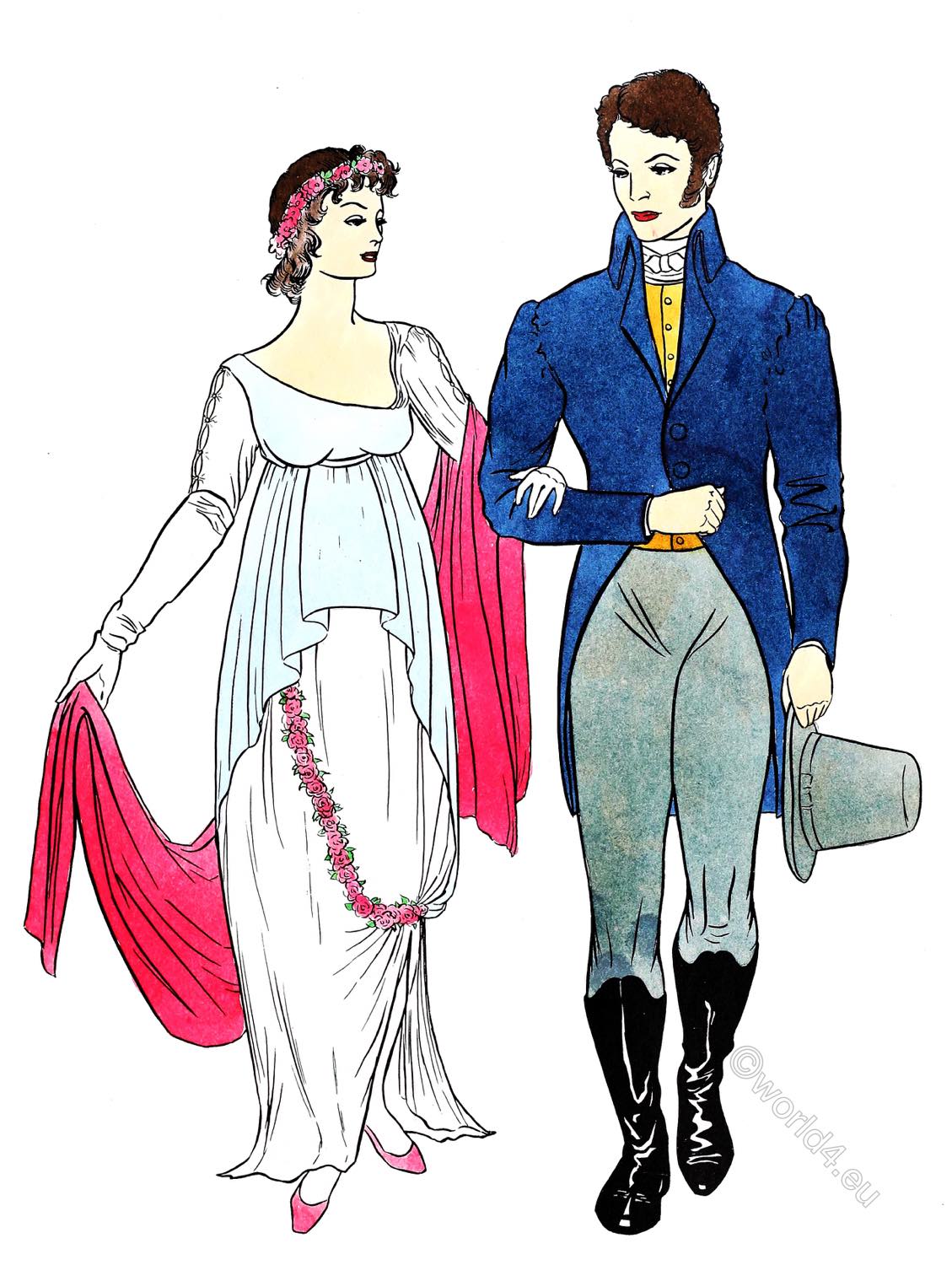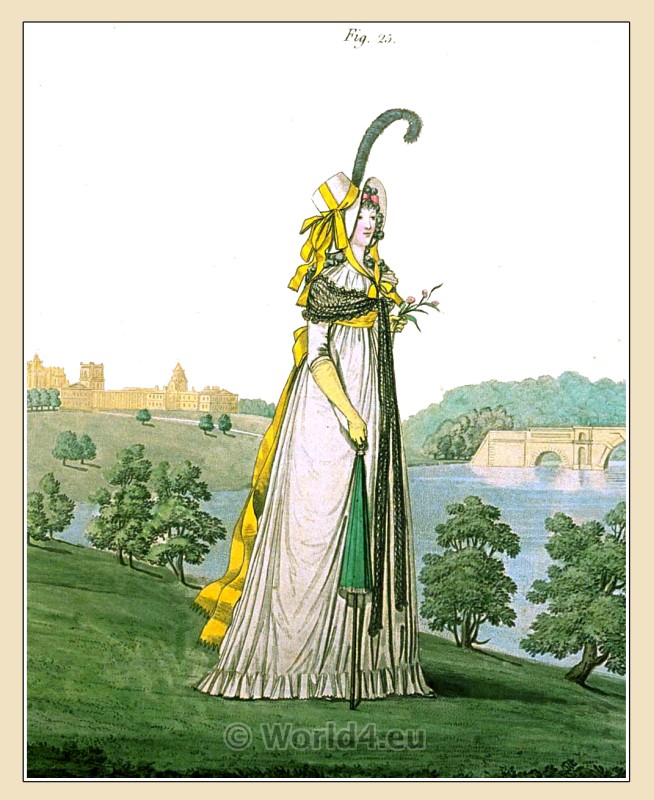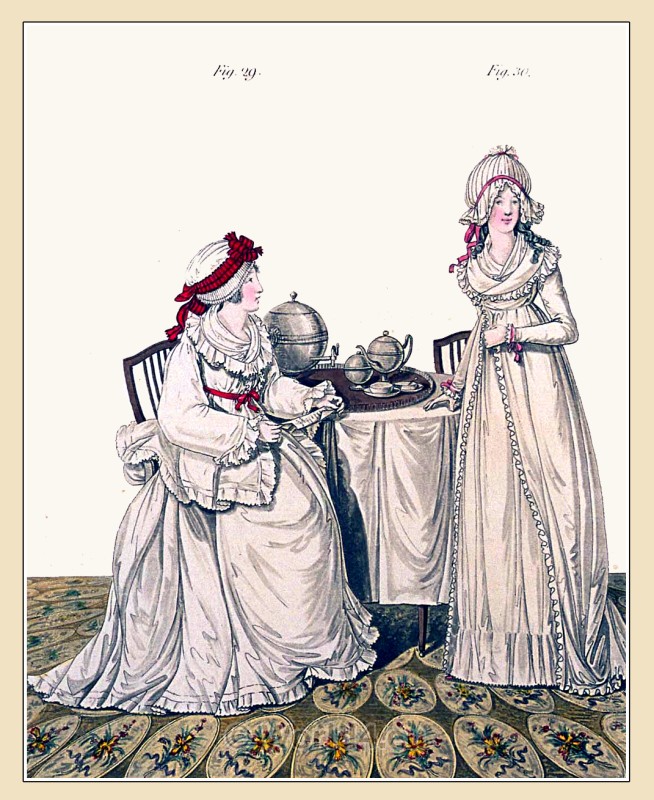
1 2 3
4 5 6
FRANCE XVIII ANNIVERSARIES. 1775-1785. THE GREAT OR ROBE OF STATE. GENERAL FASHION TYPES.
Fashion drawings.
No. 2. young lady of state in state gown, styled with a little bonnet à la Victoire. Large closed robe à la française, pleated at the back, smooth at the front. The bust is decolted, the waist is laced. The decoration consists of straight pleated blondes curled at the edges 1). The folds of the adornment are divided by two transverse bands of pleated blonde with eight little poufs, from which a puffed band descends crosswise. A similar band strip marks the waist. Two straight pleated blonde strips descend from the wedge-shaped pointed bodice; bouquets of flowers are interspersed between the garnish.
A high ruffle, straight pleated, also divided by two blonde stripes, the lower of which merges into a double arch with the upper one below a bouquet. A puffed band wraps around both.
Triple cuffs and appropriately garnished sleeves. Around the neck a collar of black blonde, higher in the back than in the front. Pearl necklace, fastened with two golden tassels.
Hairstyle à la physionomie with open, protruding pouf and four divided curls. A string of pearls across the brothel. Bonnet à la Victoire, entwined by a double laurel branch and surmounted by three ostrich feathers. A wide gauze bow at the back; the puffed chignon held by a closed bow.
(Figur von Desrais aus der Galerie des modes et costumes français, begonnen 1778).
Nr. 5. Hairdressing aux Charmes de la Liberté. You can read on the original engraving: “Se trouve chez Depain, coiffeur de dames et auteur de cette coiffeur, rue Saint-Honoré, au coin da celle d’Orléans, au 1er au-dessus du caffé, an Grand Balcon, N. B. Le Sr Depain continue toujours d’enseigner l’art da coiffeur.” (“Is at Depain’s, ladies’ hairdresser and author, rue Saint-Honoré, on the corner of the rue d’Orléans, 1st above the caffé, an Grand Balcony, N. B. Sr Depain still continues to teach the art of hairdressing.” )
No. 3: The beautiful Suzon, figure drawn by Watteau the Younger This figure forms part of the series of costumes for fashion ladies published by Jacques Esnauts and Michel Rapilly.
The name Suzon owes its origin to the success that the actress Louise-Jeanne-Françoise Contat had gained as Susanne in the Marriage of Figaro 2).

General fashion types.
No. 4 and 6.
These figures are drawn by Augustin de Saint-Aubin. They belong to the years 1777-1778.
No. 1 was engraved by an unknown person after a red chalk drawing. It is marked: Étude pour les Demoiselles. It bears the number 817 and probably belonged to a larger series. The type of the costume refers to 1776-1778. The straight robe with the puffed cap leaves the foot free.
See E. und J. de Goncourt; La Femme au XVIIIe siècle. – Quicherat, The History of Costume in France. – Le Cabinet des modes ou les modes nouvelles, 1785.
1) French blonde; blond (according to the colour of the raw silk used). Fine silk lace with floral and figural patterns.
2) Louise-Jeanne-Françoise Contat, known as Contat the Elder, was a French actress of the Comédie-Française, born on 17 June 1760 in Paris, where she died on 9 March 1813. She played the role of “Suzanne” in Beaumarchais’ Le Mariage de Figaro.
Source: History of the costume in chronological development by Albert Charles Auguste Racinet. Edited by Adolf Rosenberg. Berlin 1888.






